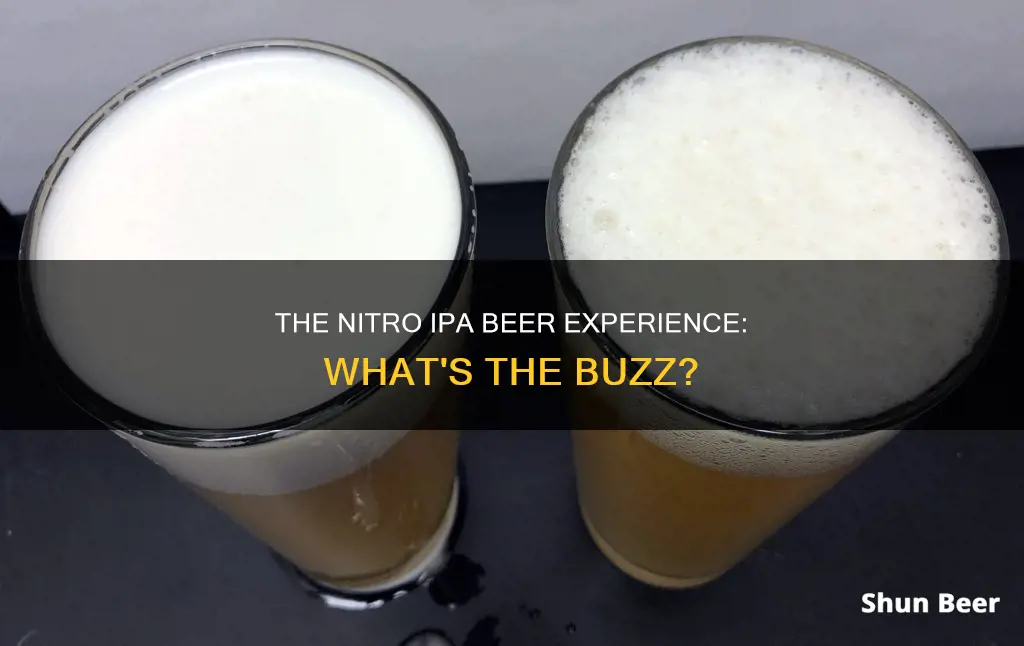
Nitro IPA beer is a type of beer that has been nitrogenated, meaning it has been infused with nitrogen gas. Nitrogen is largely insoluble in liquid, which creates a thick, creamy mouthfeel and a waterfall or whirlpool effect of tiny bubbles in the glass. Nitro beers are typically smoother and fuller-tasting than beers carbonated with carbon dioxide (CO2) and tend to emphasise malt flavours while muting hop flavours and aromas.
| Characteristics | Values |
|---|---|
| Mouthfeel | Slicker and smoother than CO2 |
| Texture | Fuller and creamier than CO2 |
| Bubbles | Appears to be falling rather than rising |
| Taste | Less hoppy and more malt-heavy |
| Visuals | Whirlpool effect with tiny bubbles |
What You'll Learn

What does nitro IPA beer look like?
Nitro IPA beer has a distinct appearance that sets it apart from traditional beers. When poured, a nitro IPA will exhibit a cascading or waterfall effect, with tiny bubbles slowly descending to form a thick, dense foam head. This foam head is notably more substantial and long-lasting compared to that of a typical beer, and it leaves behind profound lacing on the glass.
The colour of a nitro IPA can vary, but it often tends towards darker hues, with porters and stouts being popular styles served on nitro. The thick, creamy foam contrasts beautifully against the backdrop of the beer's hue, creating a visually appealing presentation.
The nitro IPA's appearance is not just about aesthetics; it also hints at the beer's flavour and mouthfeel. The dense foam and cascading bubbles indicate a smoother, creamier texture compared to beers carbonated solely with carbon dioxide (CO2). The nitro IPA's appearance foreshadows a more rounded flavour profile, where the sharpness of hop flavours and aromas is softened.
While the specific ingredients and brewing techniques can also influence the appearance, the use of nitrogen in the carbonation process is the primary driver of the distinct visual characteristics of a nitro IPA. The insolubility of nitrogen in liquid contributes to the formation of those tiny, slow-rising bubbles and the thick, creamy head.
In summary, a nitro IPA beer is characterised by its mesmerising cascade of tiny bubbles, thick foam head, and creamy texture. The appearance of a nitro IPA is an integral part of the overall sensory experience, enticing drinkers with its unique visuals before they even take their first sip.
Explore the World of IPA Beers and Their Unique Taste
You may want to see also

How does nitro beer taste?
Nitro beers are known for their unique texture and taste. The use of nitrogen gas in the carbonation process gives the beer a smooth, creamy mouthfeel, with tiny bubbles that create a thick, full head. The nitrogen also dulls the bitterness of the beer, accentuating the malt flavours and creating a fuller mouthfeel compared to carbon dioxide-carbonated beers.
The addition of nitrogen gas, which is largely insoluble in liquid, results in a slower release of bubbles and a smoother texture. This is in contrast to traditional beers carbonated with carbon dioxide, which have a more lively, prickly texture. The nitrogenation process also affects the aroma of the beer, giving it a subtle silkiness.
When poured, nitro beers exhibit a cascading or waterfall effect, with the nitrogen bubbles appearing to move downward into the beer. This is a result of the nitrogen rushing downward in the glass as it escapes, creating a whirlpool effect with fragrant foam on top. The thick and creamy foam of a nitro beer can have a slight bitterness and citrus notes, complementing the silky texture of the beer.
The flavour and aroma of the beer are also impacted by the nitrogenation process. Nitro beers tend to emphasise malt flavours while muting hop flavours and aromas. This is why nitro beers are more commonly used for dark beers, such as stouts and porters, as the thicker, creamier mouthfeel pairs well with the flavours of these beers. However, there has been a recent push to experiment with nitrogenation in other styles, such as IPAs, reds, browns, and cream ales.
Overall, the taste of nitro beer is characterised by a smooth, creamy texture, a subtle aroma, and a muted bitterness. The nitrogenation process creates a unique sensory experience that has gained a dedicated following among craft beer enthusiasts.
Guinness Beer: Available in Kolkata?
You may want to see also

What is the history of nitro beer?
Nitro beer has been dubbed a fad at various points in its history, but it has endured as a fixture of modern drinking culture. The history of nitro beer began with traditional English and European ales served in pubs and brewpubs, which were developed before forced carbonation or refrigeration. To carbonate beer, pubs used beer engines – hand pumps that pressurised the beer as it was dispensed. As air is 78% nitrogen, this was technically a nitrogenation process, but it also introduced oxygen into the beer, which lowered its shelf stability and led to off-flavours and aromas.
Forced carbonation was introduced to brewing as a way to create a bubbly product with the right flavour and mouthfeel without introducing oxygen. In the 1950s, Guinness hired mathematician Michael Ash, who had the idea to use nitrogen in beer. It took four years to perfect the process, but in 1959, pints of Guinness began using nitrogen to achieve a creamy taste and signature cascading effect.
Guinness also invented the widget – a plastic ball that releases nitrogen into the beer when the can or bottle is opened. In 2004, this was voted the greatest invention of the last 40 years in the UK. In 2011, Left Hand Brewing introduced the nitro beer concept to American craft beer fans without the use of a widget, changing craft beer history forever. This success influenced other craft brewers like Samuel Adams and Firestone Walker to create their own nitro beer options.
The Many Points of IPA Beer
You may want to see also

How is nitro beer made?
Nitro beers are made by infusing beer with nitrogen instead of carbon dioxide. This process creates a complex beer with a smooth, velvety texture, a unique taste, and a mesmerising appearance. The small, fine nitrogen bubbles create a cascade effect as they rise through the glass, topped with a fluffy, white head.
To serve nitro beer on tap, you need a nitrogen cylinder, a nitrogen regulator, and a nitrogen (stout) faucet. The beer is forced through small holes in the faucet, knocking carbon dioxide out of the solution and creating the famous cascade and creamy head. The serving pressure for nitro beer is typically between 30 and 35 psi, and the beer is served at a temperature of 40°F.
Nitro beers can also be packaged in pressure-sealed kegs or cans/bottles. For packaged beers, liquid nitrogen is infused into the beer, and it is then sealed in a pressure-sealed container. When the container is opened, the pressure drops, and the nitrogen escapes, creating the swirling nitro effect as it dances out of the glass.
The process of making nitro beer was popularised by Guinness, which nitrogenated its stouts to create a consistent and unique product. Nitro beers typically include stouts, porters, and darker ales, but the process can be applied to any type of beer.
Guinness Beer: Does It Expire?
You may want to see also

Where can I buy nitro beer?
Nitro beers are known for their smooth, creamy texture and unique, aromatic flavour. If you're interested in trying one, there are a few options for where to buy them.
One option is to check your local bars and pubs. Some establishments may have nitro beers on tap, especially if they have a rotating selection of craft beers. It's worth asking the staff about their current offerings and if they plan to have any nitro beers available in the future.
Another option is to visit a specialty beer store or a well-stocked liquor store. These stores often carry a wide variety of beers, including craft beers and limited-release beers. You can ask the staff if they carry nitro beers or if they can special order them for you.
Additionally, you can check online retailers and delivery services. Some websites specialise in selling craft beers and may have a selection of nitro beers available. You can also try using beer finder apps, such as BeerMenus, which can help you locate specific beers in your area. Simply search for "nitro IPA" and see what options are available near you.
Keep in mind that the availability of nitro beers may vary by region, and some brands may have limited distribution. For example, Fegley's Brew Works offers a nitro IPA called Allentown Brew Works, but it may only be available in certain locations. Similarly, Bissell Brothers offers a nitro version of their flagship IPA, but the availability may be limited.
Finally, if you're feeling adventurous, you can try brewing your own nitro beer at home. There are recipes and guides available online that can walk you through the process, such as the "Nitro Hazy IPA Recipe" by Brewing with Briess. This option allows you to customise the beer to your taste and experiment with different ingredients and techniques.
Stout Beer Basics: Guinness Extra Stout's Dark Side
You may want to see also
Frequently asked questions
A nitro IPA beer is a type of beer that uses nitrogen instead of carbon dioxide for carbonation. Nitrogen produces a smoother mouthfeel and texture than CO2, as well as a cascading effect for the carbonation—the bubbles appear to be falling rather than rising.
Nitrogen is insoluble in liquid and produces an abundance of tiny bubbles, making the beer frothy and creamy. It also mutes the flavours and aromas of the beer, emphasizing malt flavours and muting hop flavours.
Some examples of nitro IPA beers include:
- Nitro Hazy IPA
- Dogfish Head's 90 Minute IPA
- Samuel Adams Nitro IPA







